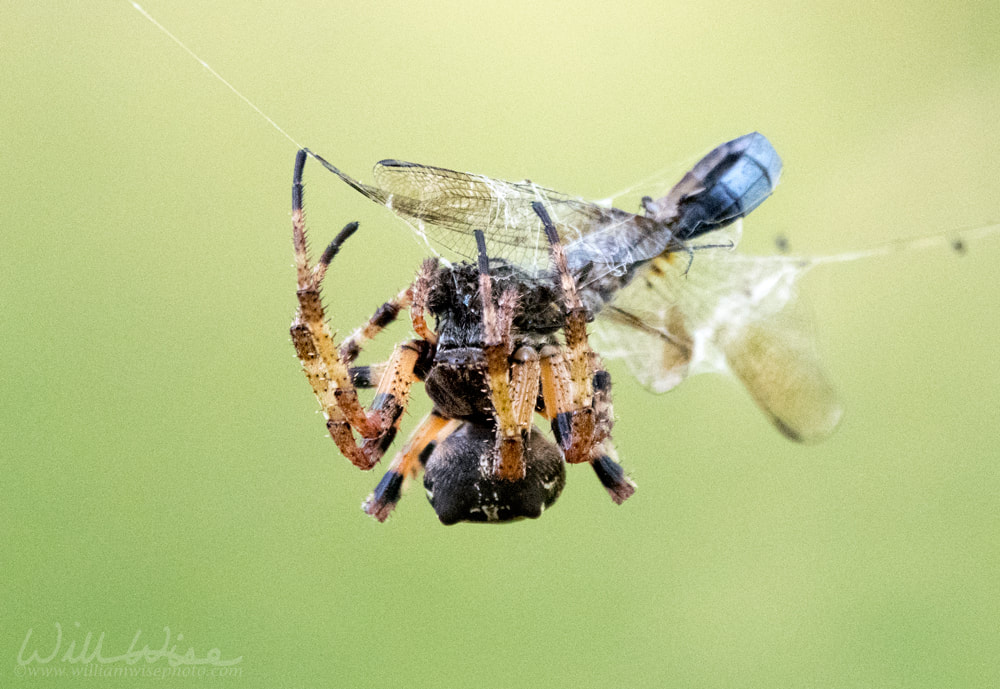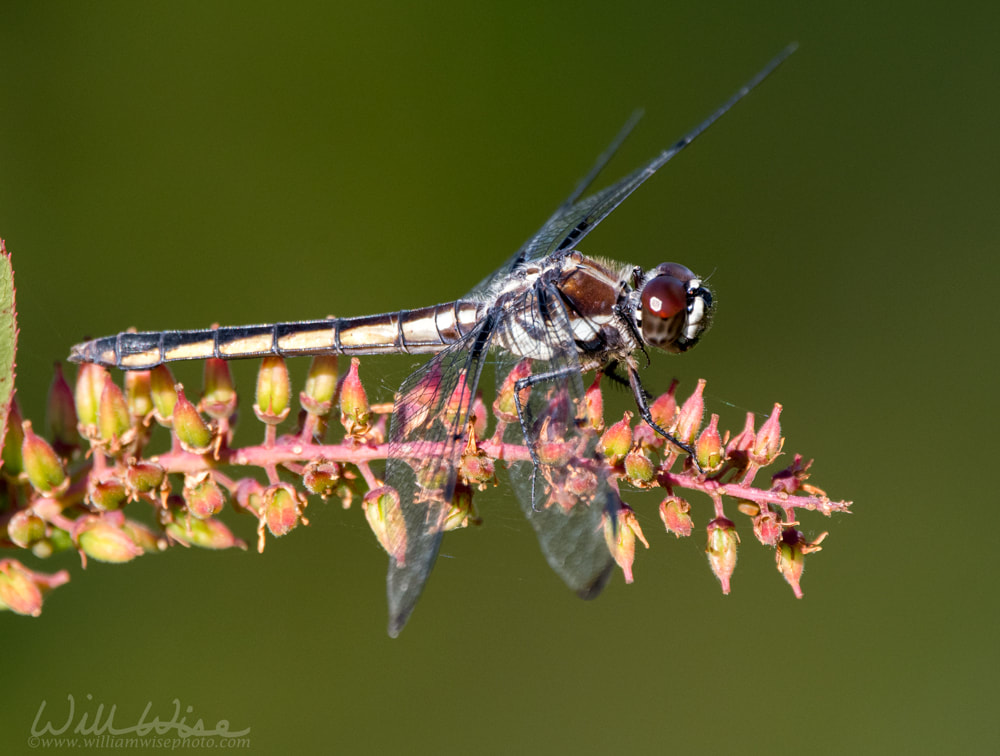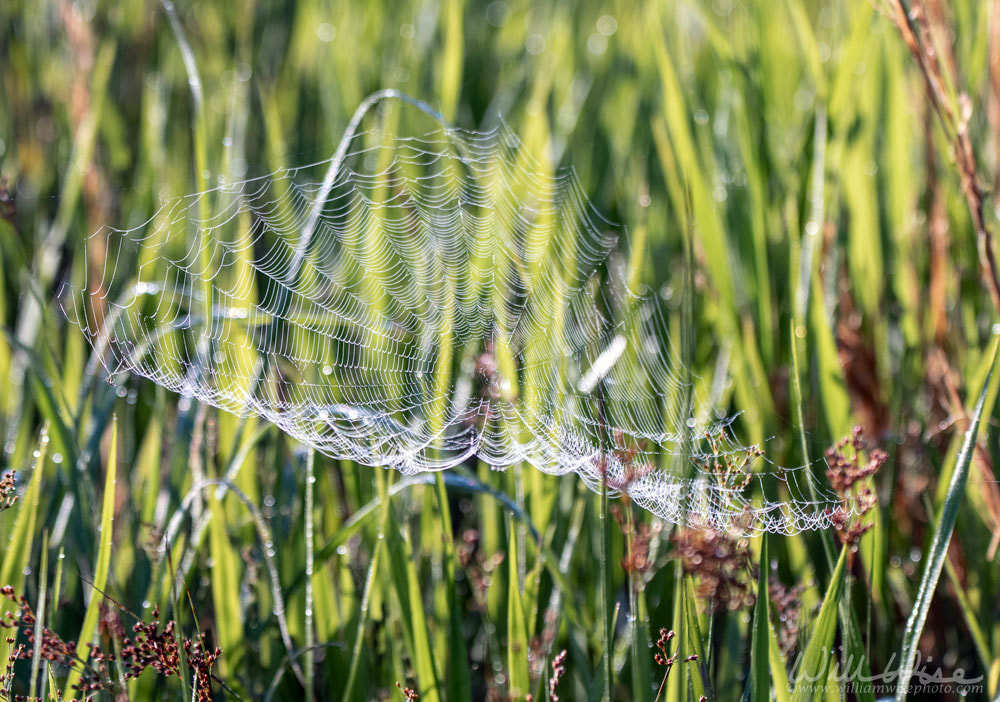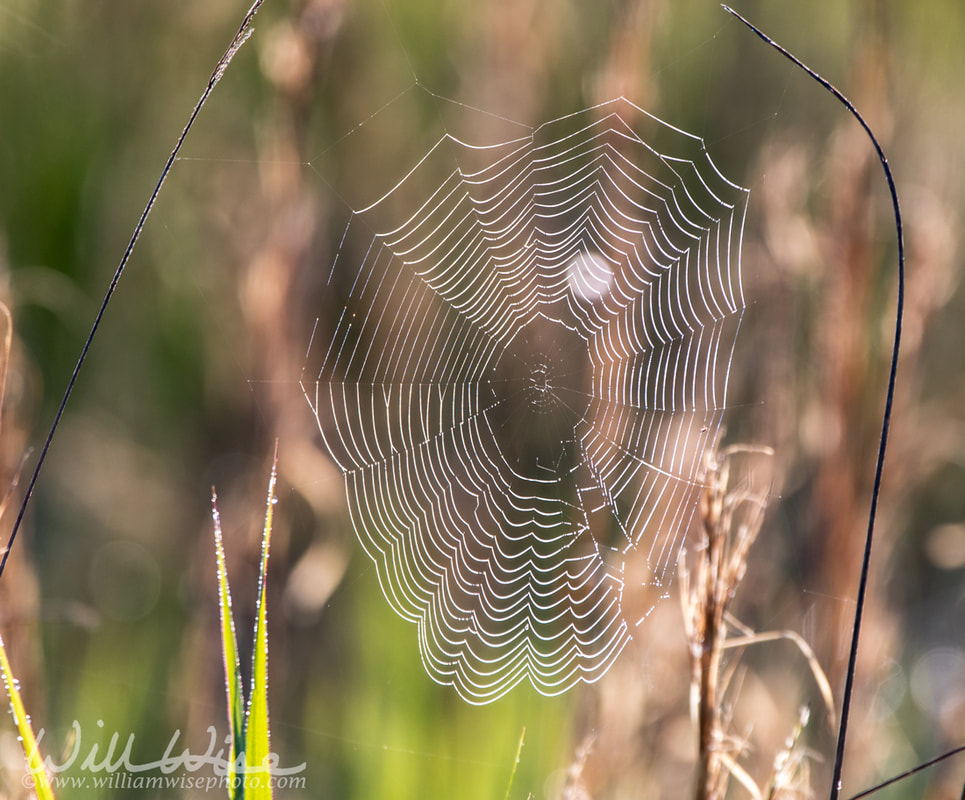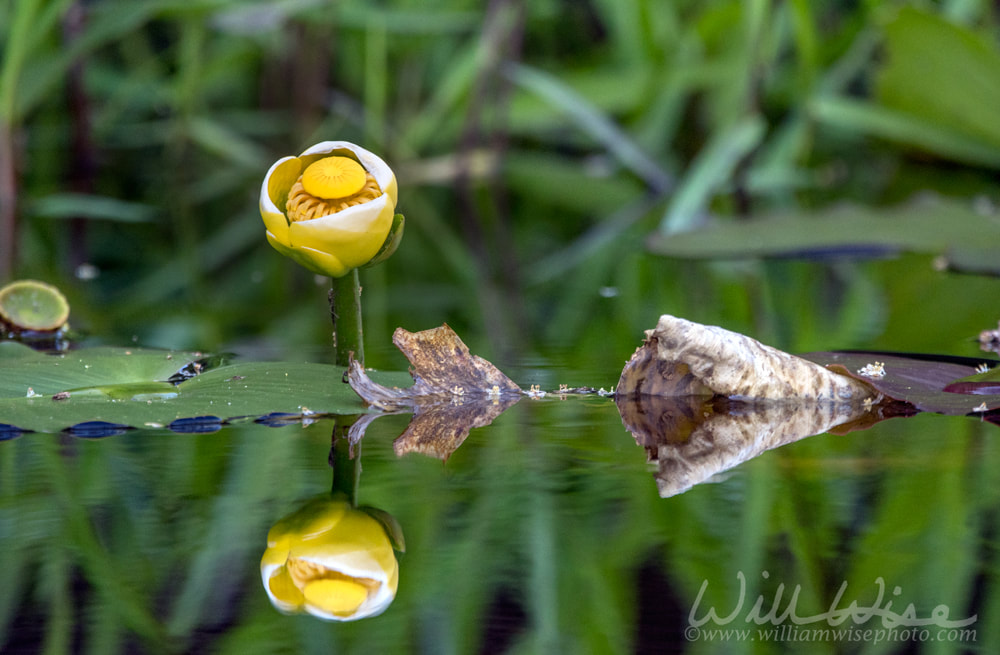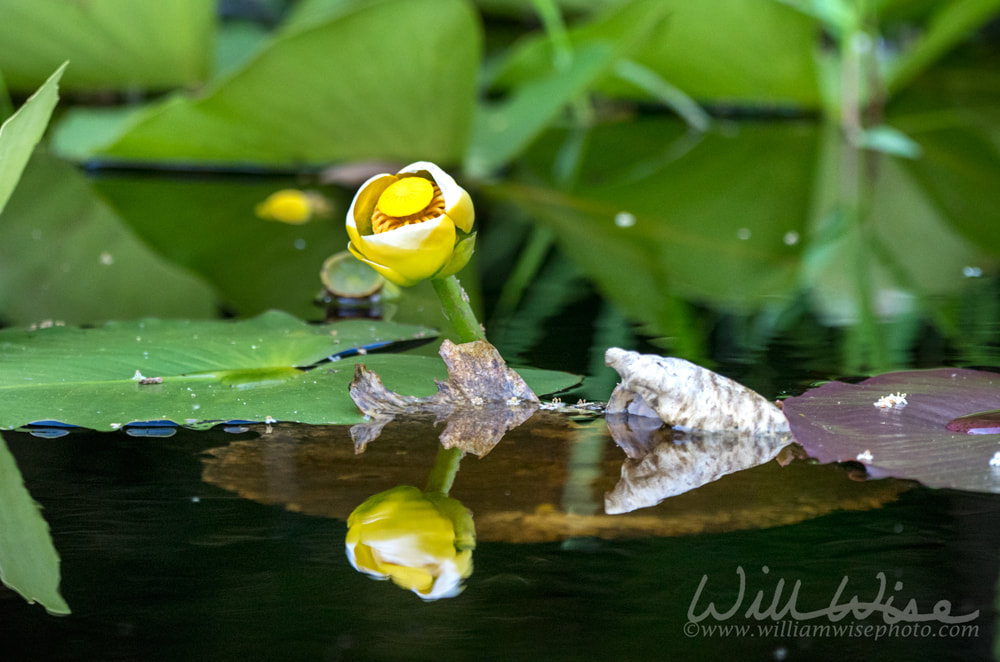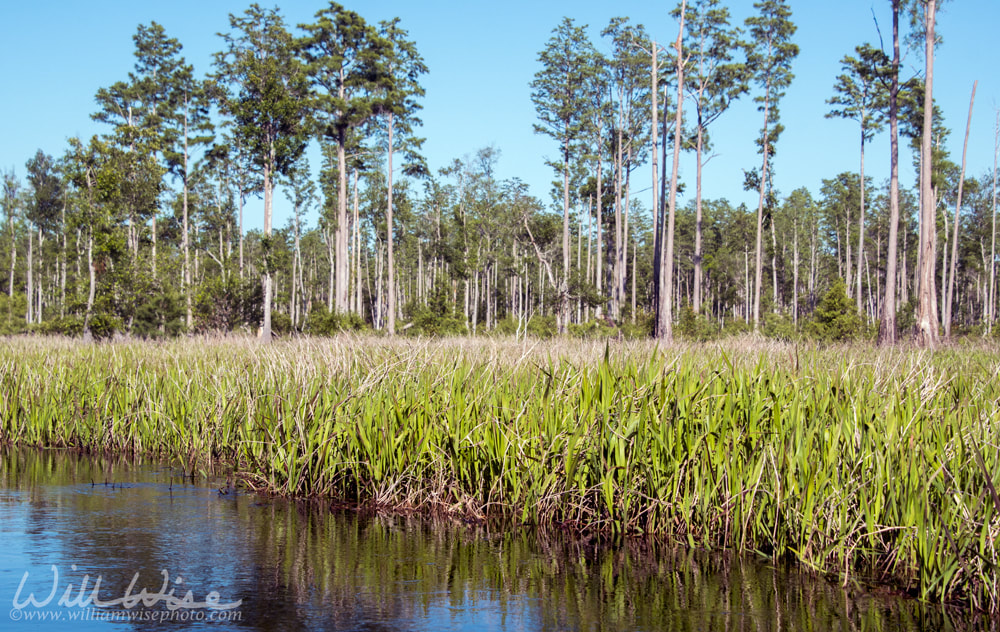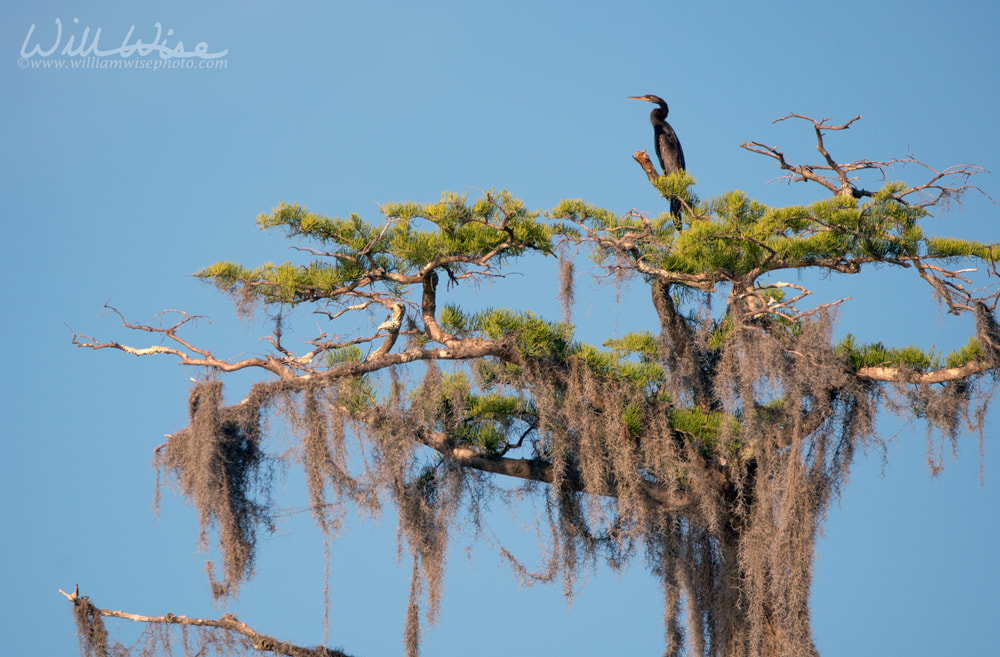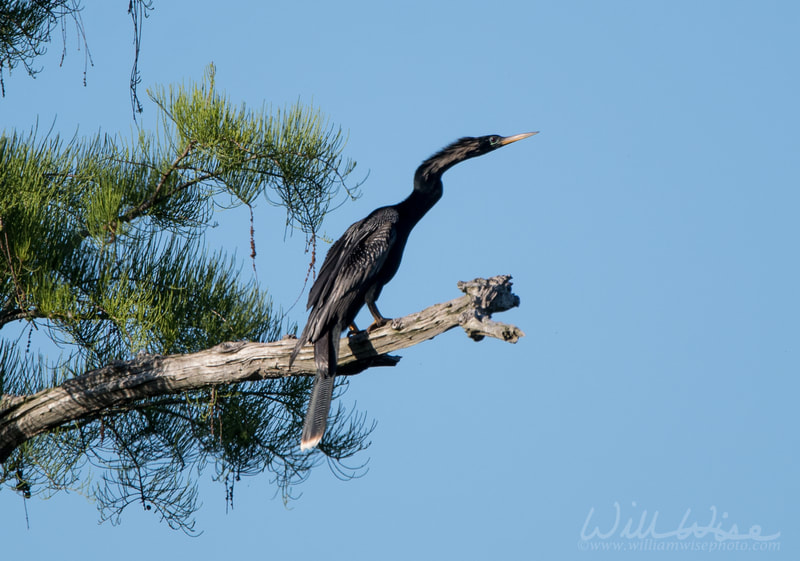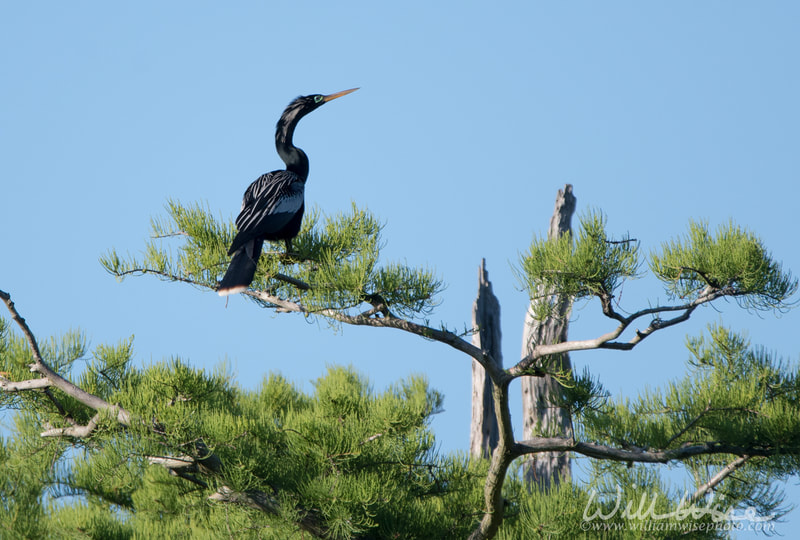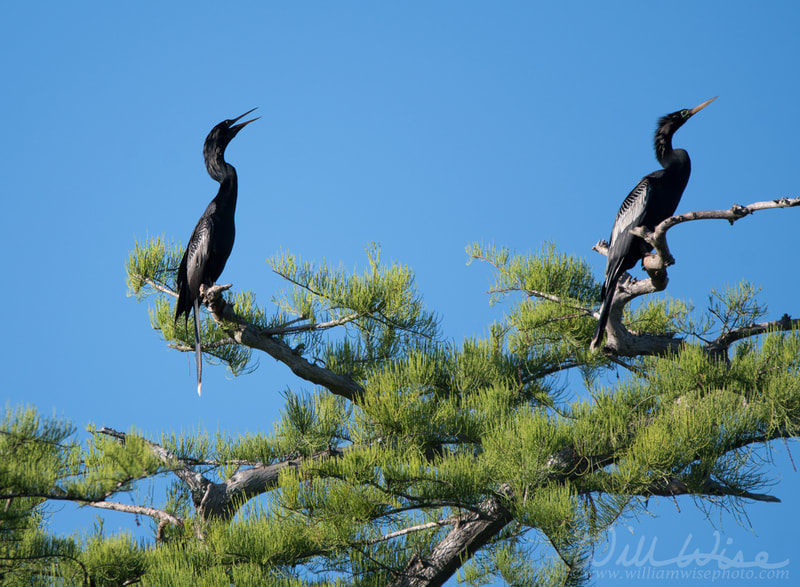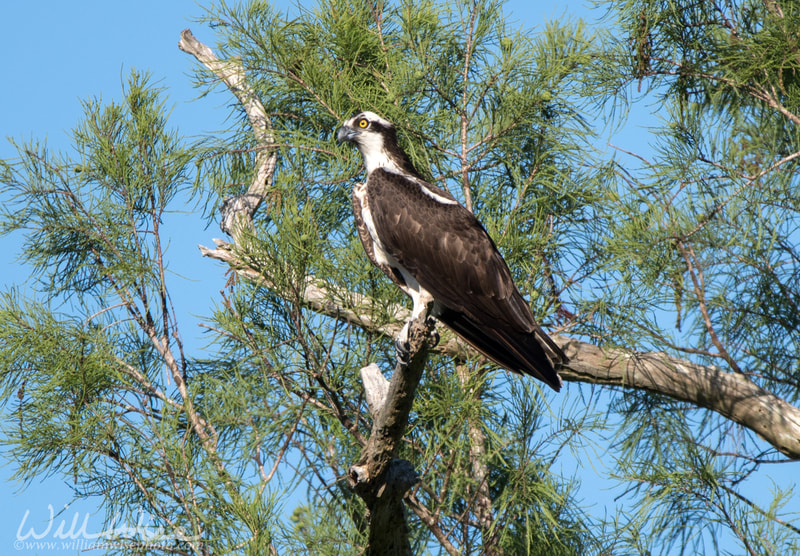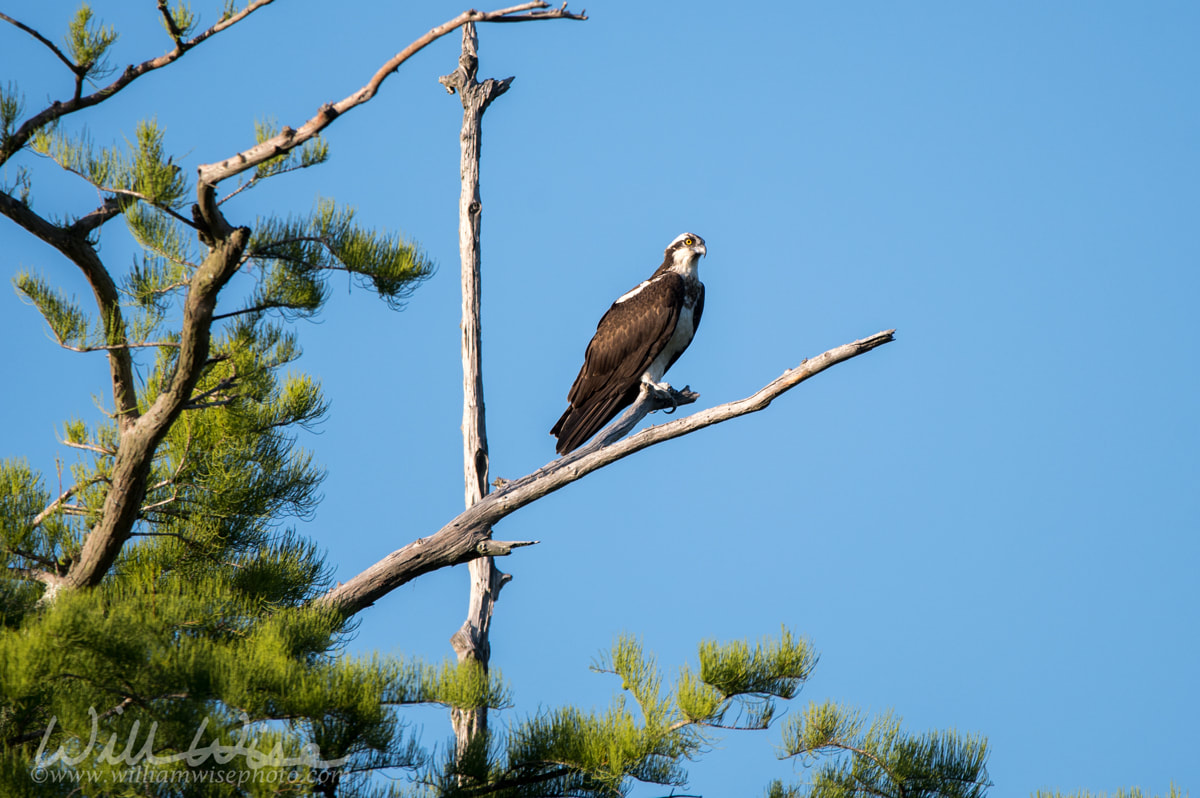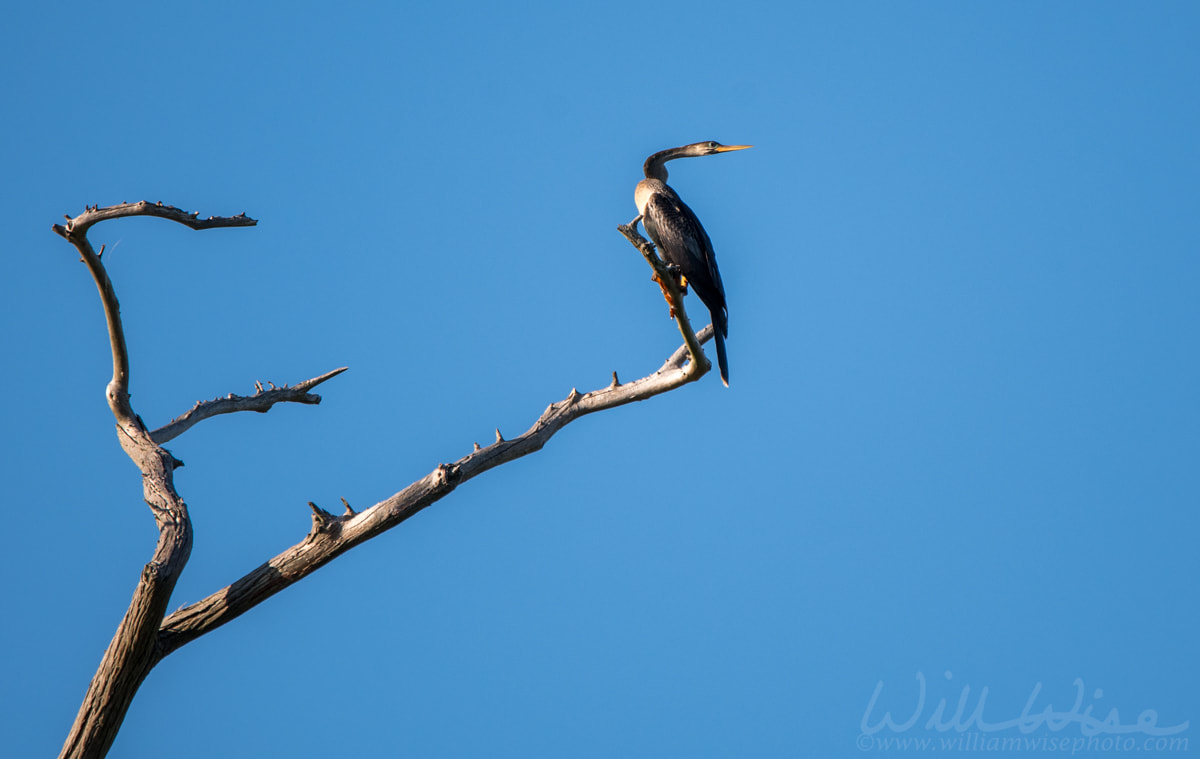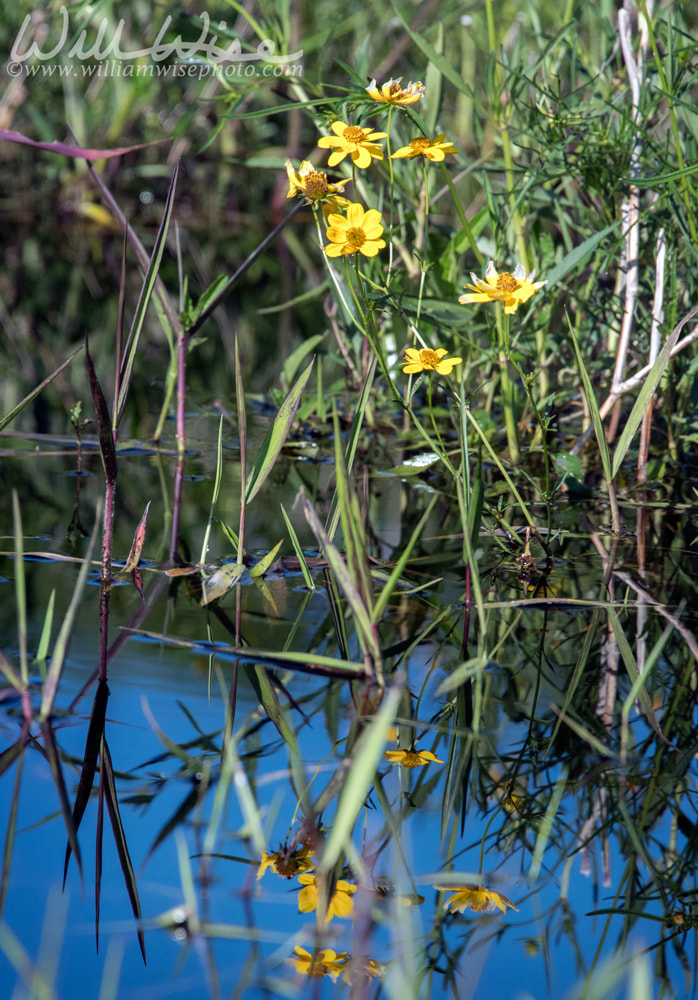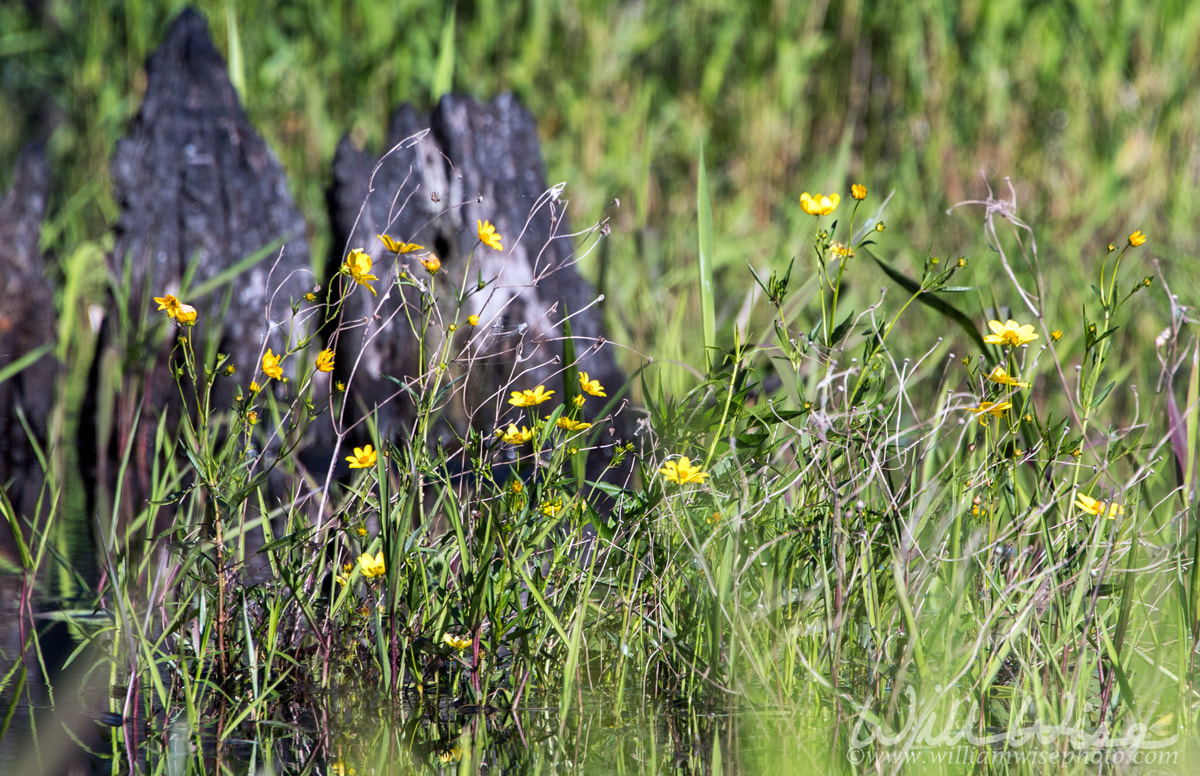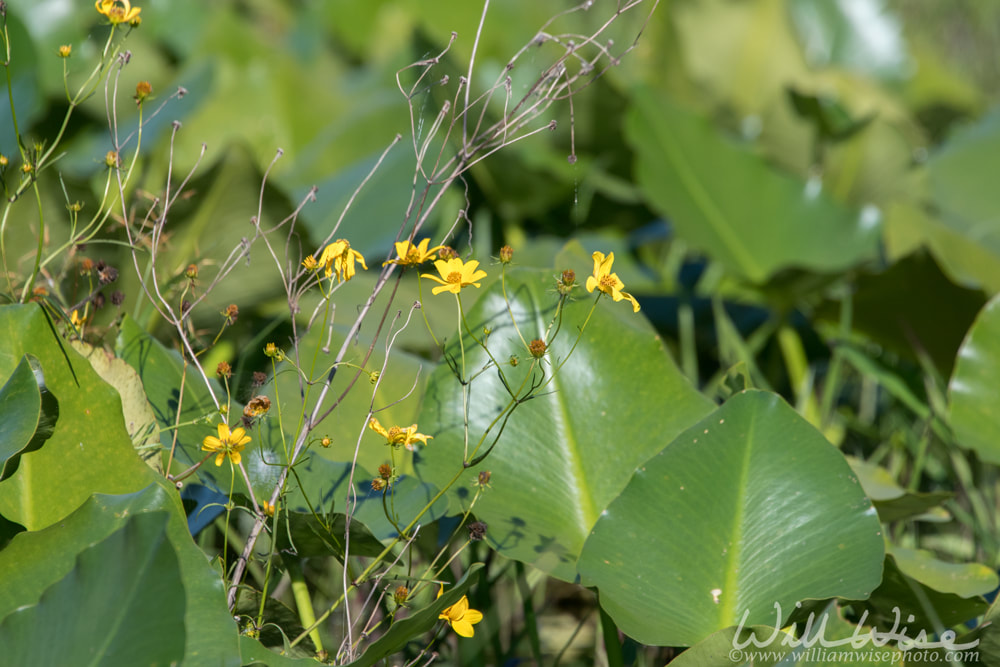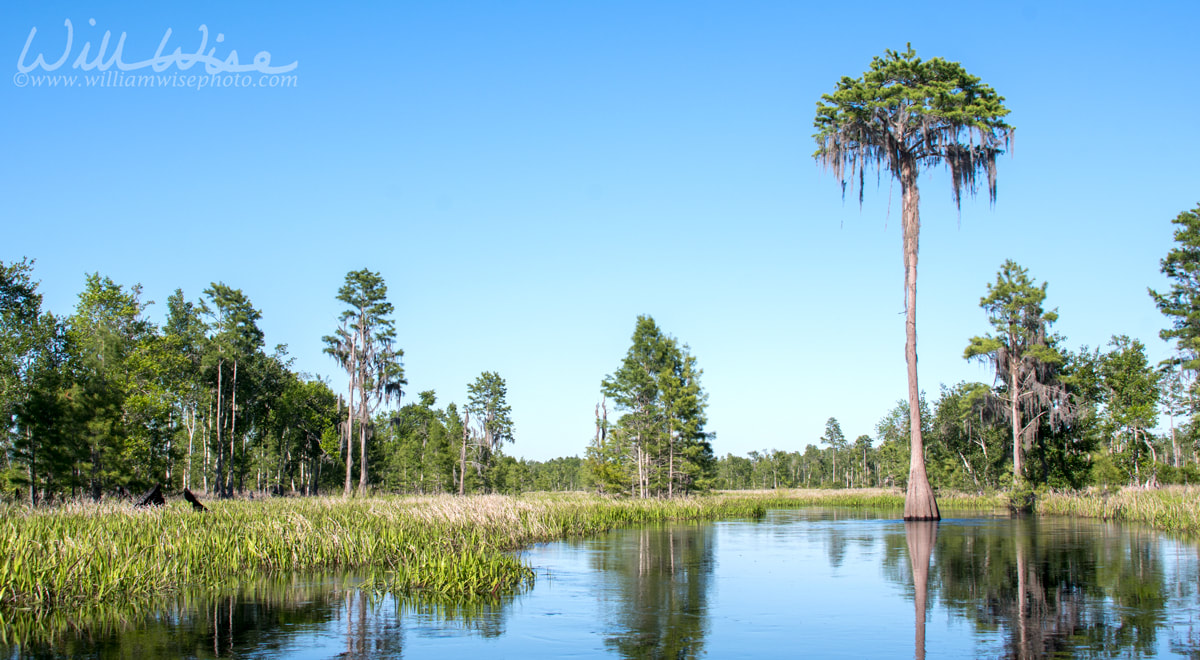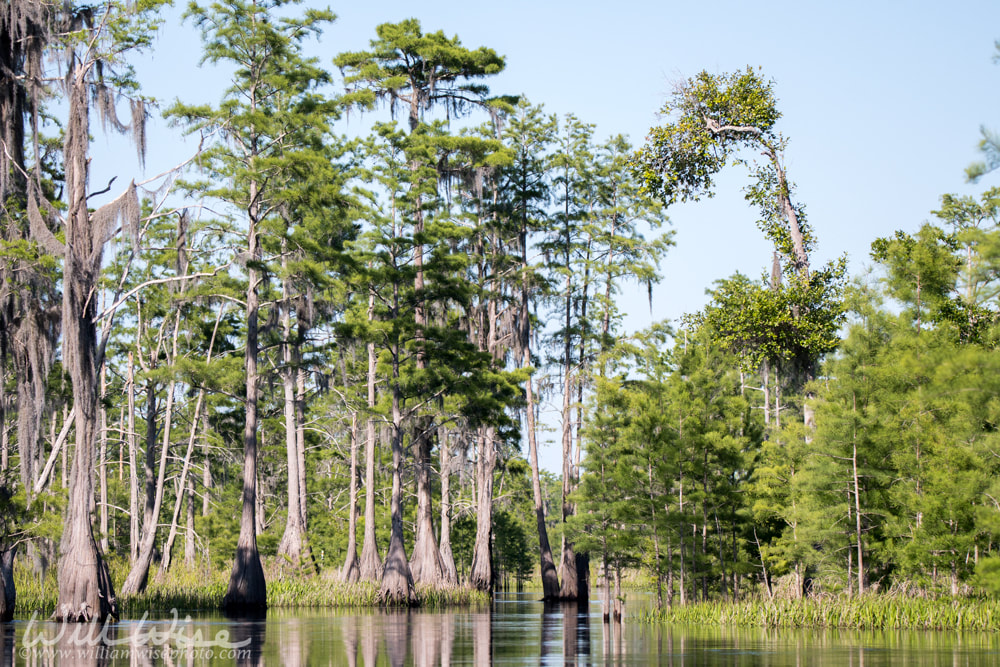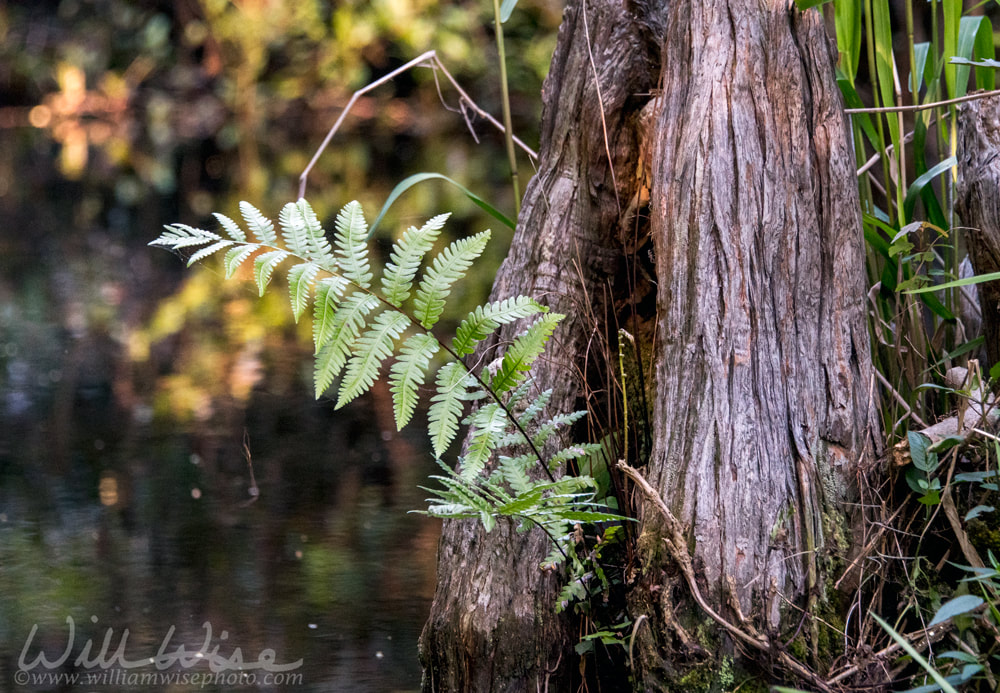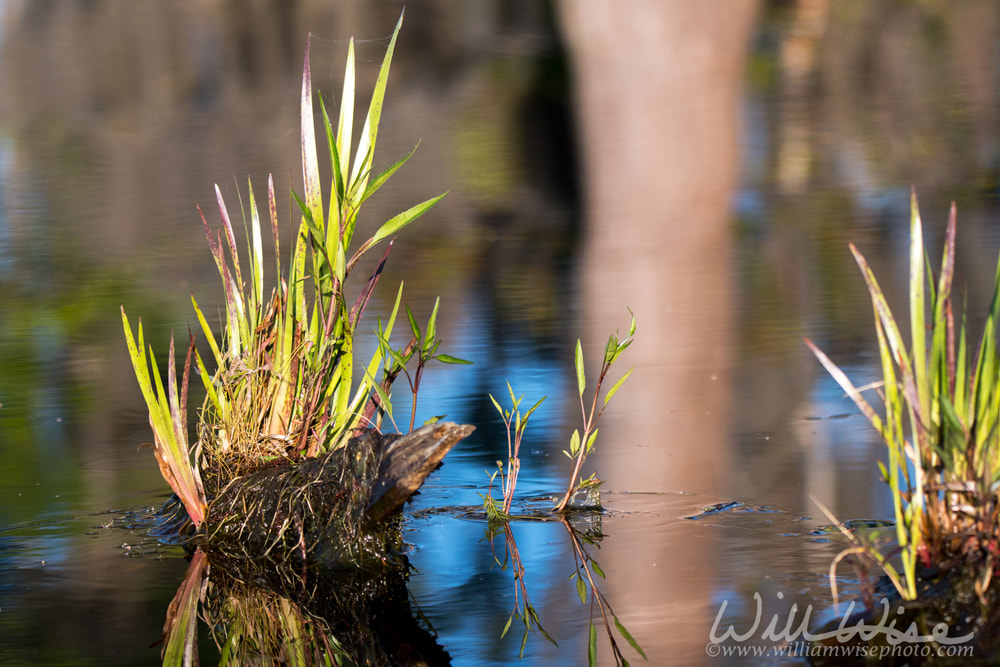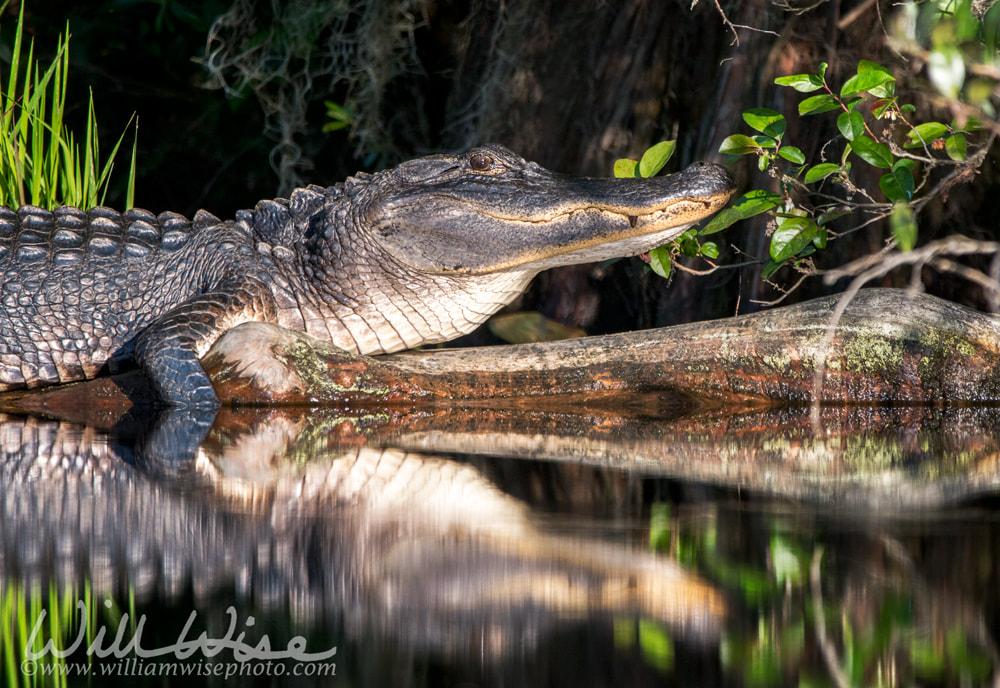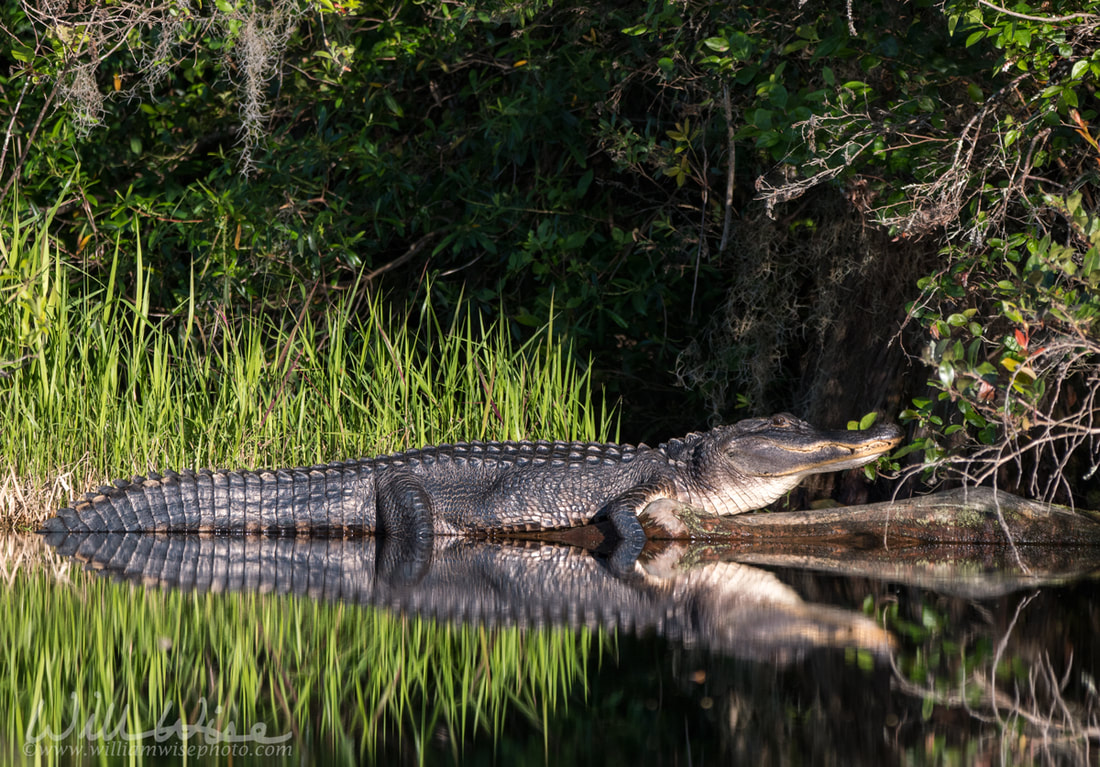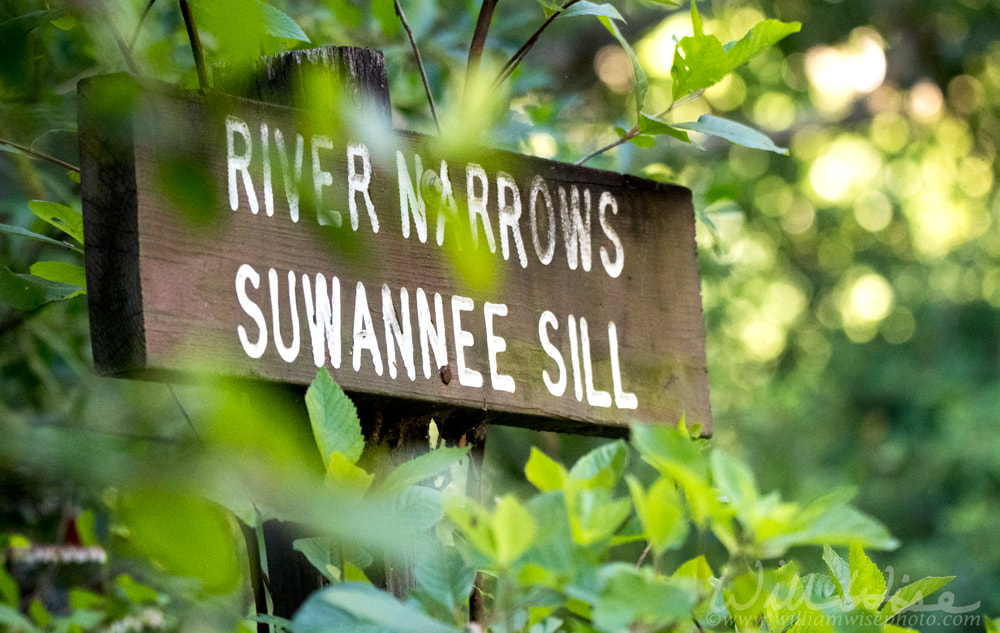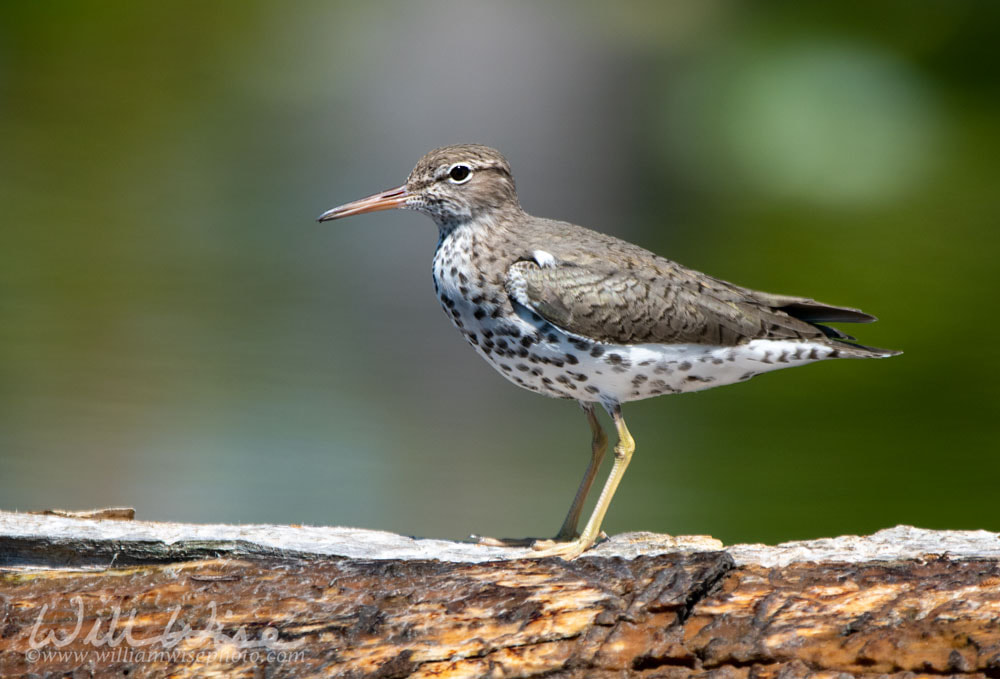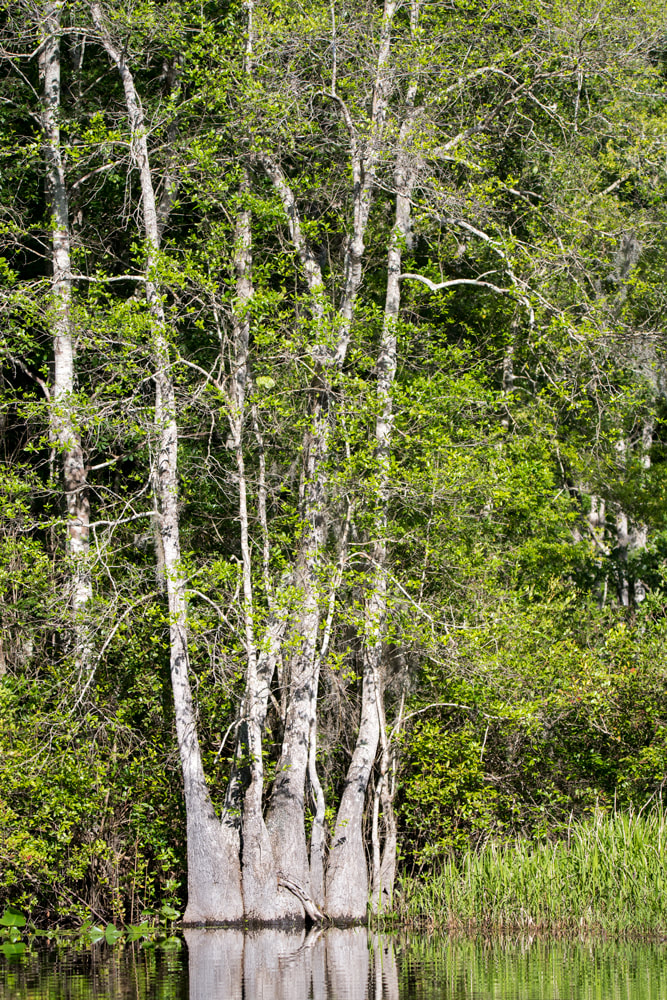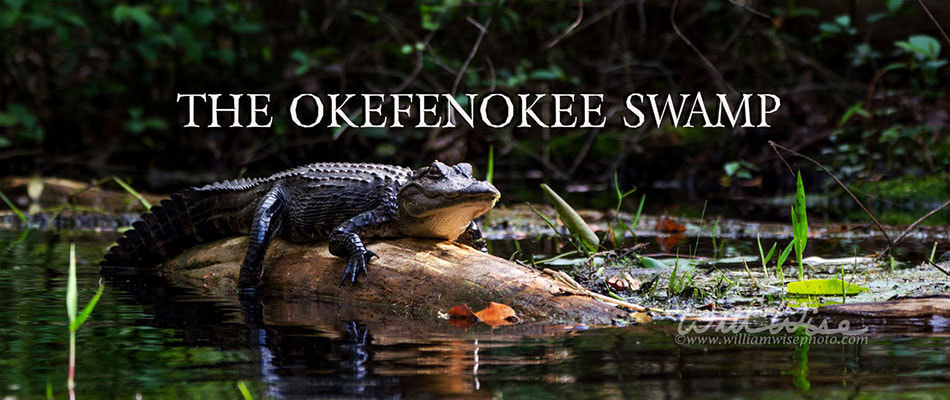 Okefenokee Photography by William Wise. A nature photo journal exploration of Georgia's Okefenokee Swamp, the Land of Trembling Earth, one of the largest blackwater swamps in North America. The alligators, birds, snakes and wildlife of Okefenokee National Wildlife Refuge and Stephen C Foster State Park. -- "What a wildly wonderful world, God! You made it all, with Wisdom at Your side, made earth overflow with your wonderful creations." Psalms 104 The Message Before the industrialist loggers of the early 20th century arrived, the Longleaf Pine dominated the upland areas surrounding the Okefenokee Swamp. Because of its ability to survive wildfires in its fire resistant “grass stage”, the Longleaf is well suited to the fire prone South Georgia landscape. The thick, grassy clump of needles protects the bud as fire sweeps through. 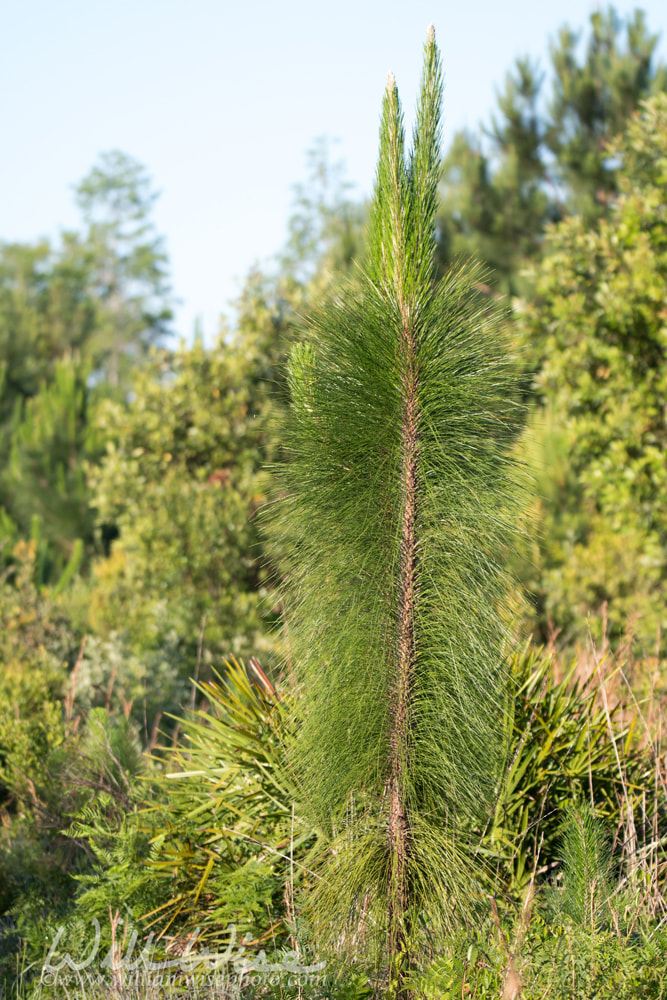 Longleaf pine, Pinus palustris, is a pine tree native to the coastal plain of the Southeastern United States. Seen here in bottle brush sapling stage. The red-cockaded woodpecker is dependent on mature Long leaf pine forests. Nature hike along the Upland Pine Trail in the Stephen C Foster State Park. Okefenokee Swamp National Wildlife Refuge in Georgia, USA. Photographed May 3, 2020. It can remain in the grass stage for years, but once the root base is established, it will rapidly take off into the “bottle brush” stage – a four-foot tall, branchless seedling that resembles a cobweb duster. It may stay in this stage for a period of time, but can adequately take in needed sunlight by staying above the lower scrub and vegetation.
After about 30 years from germination, the Longleaf Pine stands tall and nearly branchless up to the crown, resembling a green topped telephone pole. Mature stands of Longleaf Pine are essential habitat for the Red-cockaded Woodpecker.
0 Comments
 Okefenokee Photography by William Wise. A nature photo journal exploration of Georgia's Okefenokee Swamp, the Land of Trembling Earth, one of the largest blackwater swamps in North America. The alligators, birds, snakes and wildlife of Okefenokee National Wildlife Refuge and Stephen C Foster State Park. -- "What a wildly wonderful world, God! You made it all, with Wisdom at Your side, made earth overflow with your wonderful creations." Psalms 104 The Message 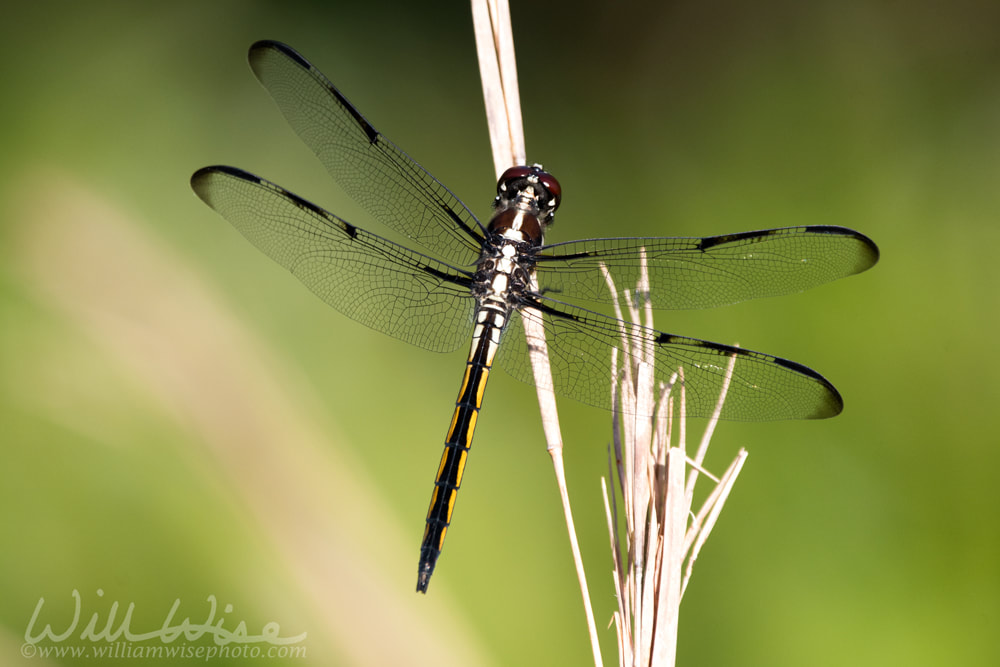 Close up of Bar Winged Skimmer, Libellula axilena, dragonfly. It is found in North America, dragonflies are abundant throughout the warm season in the swamp. They have large compound eyes and intricately veined wings. Photographed on the Trembling Earth Nature Trail in Stephen C Foster State Park; Okefenokee National Wildlife Refuge, Georgia. May 3, 2020. Skimming all throughout the Okefenokee are the gorgeous Odonata. The dragonflies adorn the swamp with their vibrant greens and blues. In the heat of the day, when most of the birds hide and the alligators sink in the cooler waters, the dragonflies are constantly buzzing about. If your camera’s autofocus is worthy, and your skill at tracking fast moving critters is even more worthy, you just might catch a flight shot. Not me… for now, I’m happy to get a photograph if one stays on a perch long enough! 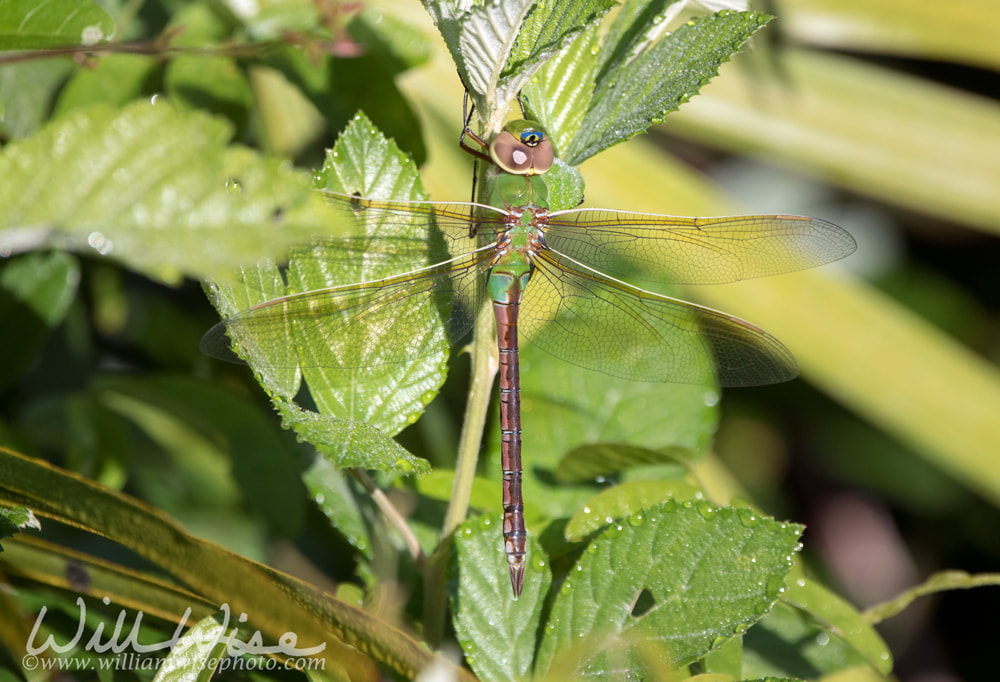 Common Green Darner, Anax junius, dragonfly. One of the most common and abundant species throughout North America, dragonflies are abundant throughout the warm season in the swamp. They have large compound eyes and intricately veined wings. Photographed on the Trembling Earth Nature Trail in Stephen C Foster State Park; Okefenokee National Wildlife Refuge, Georgia. May 3, 2020. Despite their innocent looks, and harmless alighting upon an extended finger, dragonflies are voracious carnivores! In fact, their insectivorous habits gave them the name odonata, which is Greek for “toothed”. And I suppose cannibalism isn’t out of the question, as I have once sat and watched a darner devouring another dragonfly head first. Strange Lives of Familiar Insects claims a dragonfly can ingest their own body weight in 30 minutes. 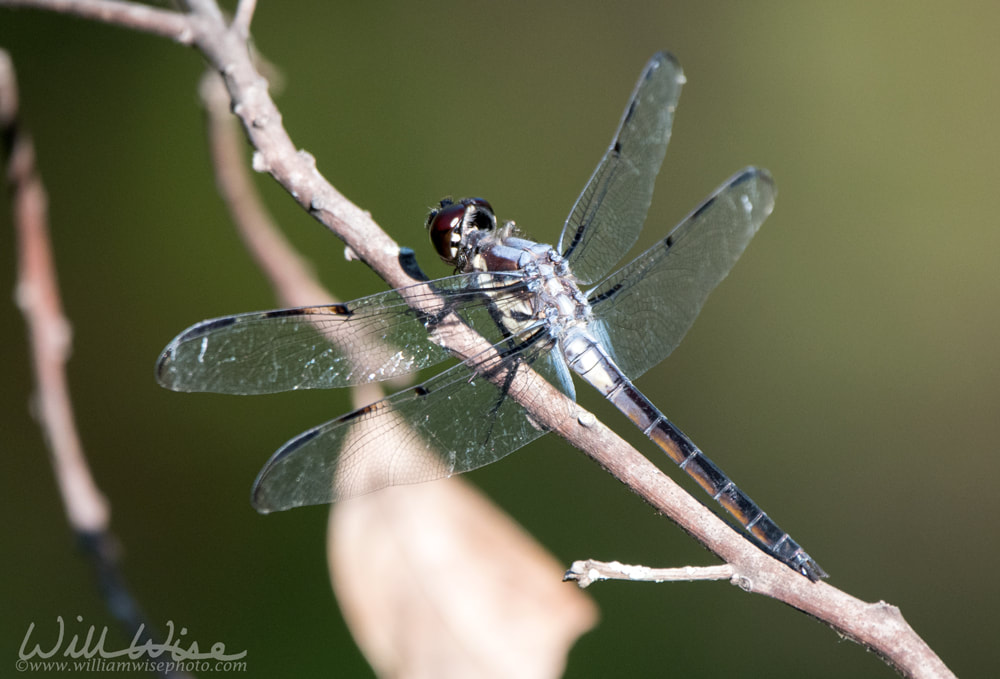 Close up of Bar Winged Skimmer, Libellula axilena, dragonfly. It is found in North America, dragonflies are abundant throughout the warm season in the swamp. They have large compound eyes and intricately veined wings. Photographed on the Trembling Earth Nature Trail in Stephen C Foster State Park; Okefenokee National Wildlife Refuge, Georgia. May 4, 2020. But in a dog-eat-dog world, sometimes the predator can become prey...  Okefenokee Photography by William Wise. A nature photo journal exploration of Georgia's Okefenokee Swamp, the Land of Trembling Earth, one of the largest blackwater swamps in North America. The alligators, birds, snakes and wildlife of Okefenokee National Wildlife Refuge and Stephen C Foster State Park. -- "What a wildly wonderful world, God! You made it all, with Wisdom at Your side, made earth overflow with your wonderful creations." Psalms 104 The Message Each Okefenokee morning, the signs of the night creatures are evident throughout the swamp. From tracks in the mud, to watery trails through the sphagnum moss, and down to the delicate details, a careful inspection reveals much about the inhabitants of the swamp.
As the orange glow of morning passes over the Okefenokee uplands, numerous webs glint and glisten across the grasses as the sun rises. Their delicate designs are highlighted by the descent of morning dew that adds crystalline droplets to each strand of the web. But the finespun designs will disappear as they tatter in the afternoon heat. Their delicate beauty passes away… until re-spun as darkness settles once again.  Okefenokee Photography by William Wise. A nature photo journal exploration of Georgia's Okefenokee Swamp, the Land of Trembling Earth, one of the largest blackwater swamps in North America. The alligators, birds, snakes and wildlife of Okefenokee National Wildlife Refuge and Stephen C Foster State Park. -- "What a wildly wonderful world, God! You made it all, with Wisdom at Your side, made earth overflow with your wonderful creations." Psalms 104 The Message 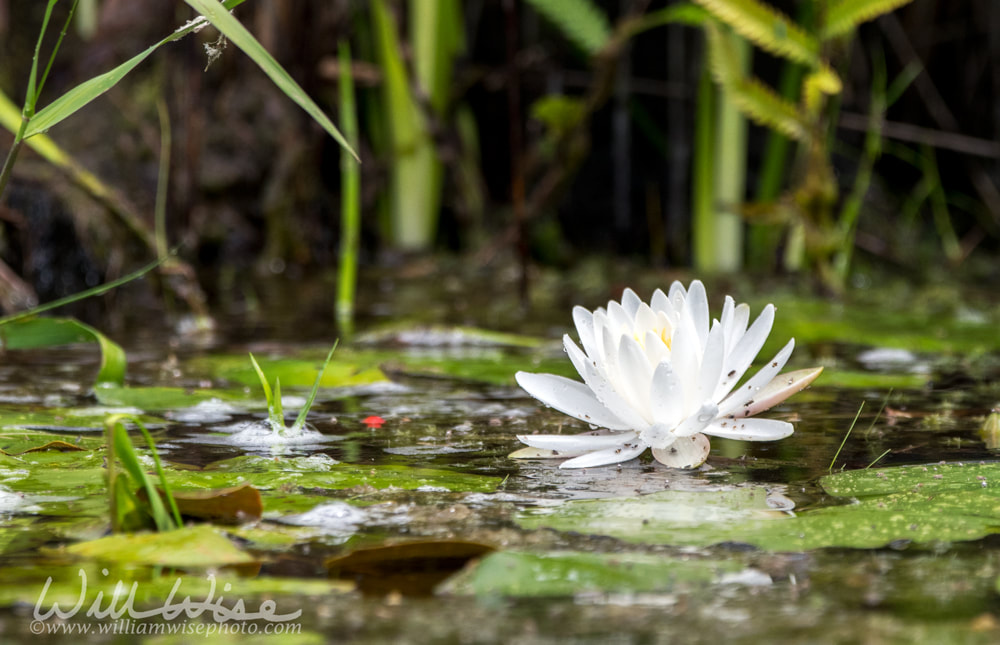 American White Water Lily flower blooming on a lily pad in the Okefenokee Swamp, Georgia. Nymphaea odorata, also known as fragrant water-lily, beaver root, sweet-scented water lily, is an aquatic plant commonly found in shallow lakes, ponds, bog, swamp and permanent slow moving waters in North America. Medical uses by Native American Indians: rhizomes for coughs and colds, stem for tooth aches. Okefenokee Swamp National Wildlife Refuge in Georgia, USA. "A man who has spent his entire life in and near the Swamp describes the setting of Gannet Lake as follows: From this lake one can look across a five-mile stretch of prairie and see the large green lily leaves floating around and the magnificent white bonnet lily blooms, which look as white as snow, shaded by the green leaves, and can also see trees here and there draped with long wisps of gray moss, all making one of the most beautiful landscapes ever been held by the eye of man.” - Excerpt from the 1926 History of the Okefenokee Swamp by AS McQueen and Hamp Mizell; page 50.
 Okefenokee Photography by William Wise. A nature photo journal exploration of Georgia's Okefenokee Swamp, the Land of Trembling Earth, one of the largest blackwater swamps in North America. The alligators, birds, snakes and wildlife of Okefenokee National Wildlife Refuge and Stephen C Foster State Park. -- "What a wildly wonderful world, God! You made it all, with Wisdom at Your side, made earth overflow with your wonderful creations." Psalms 104 The Message The flooded prairies and hammocks of the Okefenokee Swamp hold acre after acre of standing, dead wood. An abundance of snags (dead trees) means abundant woodpeckers. There are currently eight species of woodpecker found in the Okefenokee, and one formerly occurring species - the Ivory Billed Woodpecker - that is now extinct.
The excavations of the Okefenokee woodpeckers creates suitable habitat and nest cavities for other birds and wildlife as well. Taylor Schoettle writes, “Without the Pileated’s carpentry, there would be few natural cavities large enough for wood ducks to rear their young. There is hardly a time when visiting the Okefenokee that this grand woodpecker is not encountered.” (A Naturalist’s Guide to the Okefenokee Swamp; Sea to Sea Printing and Publishing, 2002).  Okefenokee Photography by William Wise. A nature photo journal exploration of Georgia's Okefenokee Swamp, the Land of Trembling Earth, one of the largest blackwater swamps in North America. The alligators, birds, snakes and wildlife of Okefenokee National Wildlife Refuge and Stephen C Foster State Park. -- "What a wildly wonderful world, God! You made it all, with Wisdom at Your side, made earth overflow with your wonderful creations." Psalms 104 The Message "WE approached the savanna at the South end, by a narrow isthmus of level ground, open to the light of day, and clear of trees or bushes, and not greatly elevated above the common level, having on our right a spacious meadow, embellished with a little lake, one verge of which was not very distant from us; its shore is a moderately high, circular bank, partly encircling a cove of the pond, in the form of a half moon; the water is clear and deep, and at the distance of some hundred yards, was a large floating field (if I may so express myself) of the Nymphea, with their golden blossoms waving to and fro on their lofty stems. Beyond these fields of Nymphea were spacious plains, encompassed by dark groves, opening to extensive Pine forests, other plains still appearing beyond them." - Excerpt from William Bartram's Travels; Part II, Chapter VI William Bartram was a botantist, artist, and nature writer that explored the southeastern United States around the time of the American Revolution (1773-1776). He was a scientist, creationist and Christian that gave glory to the Author for all the wonderful works he observed and documented in his book, Travels Through North and South Carolina, Georgia, East and West Florida.  Okefenokee Photography by William Wise. A nature photo journal exploration of Georgia's Okefenokee Swamp, the Land of Trembling Earth, one of the largest blackwater swamps in North America. The alligators, birds, snakes and wildlife of Okefenokee National Wildlife Refuge and Stephen C Foster State Park. -- "What a wildly wonderful world, God! You made it all, with Wisdom at Your side, made earth overflow with your wonderful creations." Psalms 104 The Message Excerpt from the 1926 History of the Okefenokee Swamp by AS McQueen and Hamp Mizell:
 Okefenokee Photography by William Wise. A nature photo journal exploration of Georgia's Okefenokee Swamp, the Land of Trembling Earth, one of the largest blackwater swamps in North America. The alligators, birds, snakes and wildlife of Okefenokee National Wildlife Refuge and Stephen C Foster State Park. -- "What a wildly wonderful world, God! You made it all, with Wisdom at Your side, made earth overflow with your wonderful creations." Psalms 104 The Message "From the buttress, the Cypress, as it were, takes another beginning, forming a grand strait column eighty or ninety feet high, when it divides every way around into an extensive flat horizontal top, like an umbrella, where eagles have their secure nests, and cranes and storks their temporary resting places; and what adds to the magnificence of their appearance, is the streamers of long moss that hang from the lofty limbs and float in the winds. This is their majestic appearance, when standing alone, in large rice plantations, or thinly planted on the banks of great rivers." - Excerpt from William Bartram's Travels; Part II, Chapter III William Bartram was a botantist, artist, and nature writer that explored the southeastern United States around the time of the American Revolution (1773-1776). He was a scientist, creationist and Christian that gave glory to the Author for all the wonderful works he observed and documented in his book, Travels Through North and South Carolina, Georgia, East and West Florida.  Okefenokee Photography by William Wise. A nature photo journal exploration of Georgia's Okefenokee Swamp, the Land of Trembling Earth, one of the largest blackwater swamps in North America. The alligators, birds, snakes and wildlife of Okefenokee National Wildlife Refuge and Stephen C Foster State Park. -- "What a wildly wonderful world, God! You made it all, with Wisdom at Your side, made earth overflow with your wonderful creations." Psalms 104 The Message Earlier in the year, the Okefenokee made the news as conservationists sounded the alarm against a proposal to mine thousands of acres alongside the National Wildlife Refuge. This isn’t a modern day gold rush, but a search for titanium dioxide. Even so, there’s Gold in the Okefenokee! A different sort of gold… Splashes of yellow dot the Okefenokee landscape as wildflowers of the Bidens genus bloom in the spring and summer. I have seen them growing on the prairies, in shallow waters alongside Spatterdock, and in tussocks upon old stumps in the middle of the larger lakes. They are commonly called Beggars Ticks, Bur Marigolds and Tickseed Sunflowers. They are a sun-loving wildflower and generally found in moist soils such as marshes, wet meadows and roadside ditches.  Okefenokee Photography by William Wise. A nature photo journal exploration of Georgia's Okefenokee Swamp, the Land of Trembling Earth, one of the largest blackwater swamps in North America. The alligators, birds, snakes and wildlife of Okefenokee National Wildlife Refuge and Stephen C Foster State Park. -- "What a wildly wonderful world, God! You made it all, with Wisdom at Your side, made earth overflow with your wonderful creations." Psalms 104 The Message “Every cloud has a silver lining.” While I’m typically not one to use happy little inspirational poster quotes, this one held true for me in May 2020. The coronavirus shutdown of the entire world gave many of us weeks of free time as we isolated at home. I chose to take isolation to the extreme and made a second 2020 trip to the Okefenokee Swamp National Wildlife Refuge in Georgia. There were only about twenty occupied campsites within the sixty-plus RV lots of the Stephen C Foster State Park. We all had plenty of room and privacy. And consider that us few campers were just about the only people within the Okefenokee’s 438,000 acres, that’s some serious social distancing! As I suspected, visiting at a date further into the summer, the “environmental challenges” (as my daughter coined them) were greater than our usual early spring excursions. It was quite a bit more humid, the sun rose earlier, higher and hotter than in March, and the armies of gnats and flies were mustering their ranks in greater numbers. Because of the heat, most of the alligators were now spending the majority of the mid-day submerged in the swamp waters.
Still, it is always a wonderful time to explore the Okefenokee. I concentrated a bit more on plants and “bugs” than in the past in order to contribute some diversity of Okefenokee observations to my iNaturalist Project and Okefenokee Blog.  Okefenokee Photography by William Wise. A nature photo journal exploration of Georgia's Okefenokee Swamp, the Land of Trembling Earth, one of the largest blackwater swamps in North America. The alligators, birds, snakes and wildlife of Okefenokee National Wildlife Refuge and Stephen C Foster State Park. -- "What a wildly wonderful world, God! You made it all, with Wisdom at Your side, made earth overflow with your wonderful creations." Psalms 104 The Message From the broad, sweeping bird’s-eye-view, down to the smallest detail of living organism, the Okefenokee National Wildlife Refuge is full of beauty and charm. Perhaps alligators and snakes are the first thing conjured in the mind upon hearing the word “swamp”, but peace, solitude and fascination come to my thoughts. My first visits to the Okefenokee were to photograph alligators and wildlife. Later, birds became the focus of my interest. And more recently, after several swamp excursions, the minute details of fern and twig, insect and web, lichen and flower have captured my attention. Even when not paddling through the swamp in my canoe, I am at home perusing through book after book about the habitats and ecosystem of the swamp. If you are fascinated by this natural world, you must make the Okefenokee Swamp a destination on your list of must-see parks. It is truly a place of beauty and charm!  Okefenokee Photography by William Wise. A nature photo journal exploration of Georgia's Okefenokee Swamp, the Land of Trembling Earth, one of the largest blackwater swamps in North America. The alligators, birds, snakes and wildlife of Okefenokee National Wildlife Refuge and Stephen C Foster State Park. -- "What a wildly wonderful world, God! You made it all, with Wisdom at Your side, made earth overflow with your wonderful creations." Psalms 104 The Message "THE alligator when full grown is a very large and terrible creature, and of prodigous strength, activity and swiftness in the water. I have seen them twenty feet in length, and some are supposed to be twenty-two or twenty-three feet; their body is as large as that of a horse; their shape exactly resembles that of a lizard, except their tail, which is flat or cuniform, being compressed on each side, and gradually diminishing from the abdomen to the extremity, which, with the whole body is covered with horny plates or squammae, impenetrable when on the body of the live animal, even to a rifle ball, except about their head and just behind their fore-legs or arms, where it is said they are only vulnerable. The head of a full grown one is about three feet, and the mouth opens nearly the same length, the eyes are small in proportion and seem sunk deep in the head, by means of the prominency of the brows; the nostrils are large, inflated and prominent on the top, so that the head in the water, resembles, at a distance, a great chunk of wood floating about. Only the upper jaw moves, which they raise almost perpendicular, so as to form a right angle with the lower one. In the fore part of the upper jaw, on each side, just under the nostrils, are two very large, thick, strong teeth or tusks, not very sharp, but rather the shape of a cone, these are as white as the finest polished ivory, and are not covered by any skin or lips, and always in sight, which gives the creature a frightful appearance; in the lower jaw are holes opposite to these teeth, to receive them; when they clap their jaws together it causes a surprising noise, like that which is made by forcing a heavy plank with violence upon the ground, and may be heard at a great distance." -William Bartram's Travels, Part II, Chapter V William Bartram was a botantist, artist, and nature writer that explored the southeastern United States around the time of the American Revolution (1773-1776). He was a scientist, creationist and Christian that gave glory to the Author for all the wonderful works he observed and documented in his book, Travels Through North and South Carolina, Georgia, East and West Florida. 
Okefenokee Photography by William Wise. A nature photo journal exploration of Georgia's Okefenokee Swamp, the Land of Trembling Earth, one of the largest blackwater swamps in North America. The alligators, birds, snakes and wildlife of Okefenokee National Wildlife Refuge and Stephen C Foster State Park. -- "What a wildly wonderful world, God! You made it all, with Wisdom at Your side, made earth overflow with your wonderful creations." Psalms 104 The Message
Between the open skies of Billy’s Lake and the prairie landscape of Mixon’s Hammock lies a twisting, constricted canoe trail called The Narrows. The sky overhead is darkened by Black Gum, Cypress, Bay, Red Maple and Dahoon Holly. The eye-level view left and right is overcrowded by Titi, Hurrah Bush and other shrubs. Unless the refuge cutter boats have recently passed through, sharp sticks and twigs stab toward the narrow channel hoping to impale the unskilled kayaker.
The current flows westward from Billy’s Lake toward the Sill. This seems like an advantage to the westbound paddler, but don’t be deceived. The current can carry you along so quickly that steering becomes difficult and pushes you into the scratchy shrubs lining the narrow channel. Many of these protruding limbs are tipped with spiders, and even snakes, to jump aboard the canoe. Even though the current is against you heading back to Billy’s Lake, I have found it a much more enjoyable journey with time as the steering is much more manageable.  Okefenokee Photography by William Wise. A nature photo journal exploration of Georgia's Okefenokee Swamp, the Land of Trembling Earth, one of the largest blackwater swamps in North America. The alligators, birds, snakes and wildlife of Okefenokee National Wildlife Refuge and Stephen C Foster State Park. -- "What a wildly wonderful world, God! You made it all, with Wisdom at Your side, made earth overflow with your wonderful creations." Psalms 104 The Message Scanning the shore binoculars as my daughter piloted our canoe around Billy's lake, I was a bit startled when I saw a small group of four plump sandpiper birds gathered on a downed cypress tree. Sandpipers in the Okefenokee? This was definitely a first for me. About an hour later, near the entrance of The Narrows, I saw another group of 9 standing on a log in the shade.
Apparently, I wasn't the first person to be surprised at seeing them. In 1913, Albert Wright and Francis Harper explored the Okefenokee for the American Ornithological Society. In the society's scientific journal and official publication, The Auk, they wrote of the delight in finding the Spotted Sandpiper within the great Swamp: "The Spotted Sandpiper was a distinct surprise as a summer resident of the swamp. Not only is this several hundred miles south of its known breeding range, but one would not expect it to find a suitable haunt in the Oke-finokee. The lakes and runs are practically shoreless; they are simply open spaces in the otherwise continuous cypress swamps. However, the logs and driftwood near the edges of Billy's Lake serve as teetering stands; half a dozen were seen here on May 11, one on June 5, and still another a few days later. Earlier in the spring one or two were reported from the canal. The species probably does not breed in this latitude." According to www.allaboutbirds.com, Spotted Sandpipers are "the most widespread sandpiper in North America, and they are common near most kinds of freshwater, including rivers and streams, as well as near the sea coast"... and apparantly blackwater swamps as well! Looking at eBird's illustrated checklist for Charlton County, the Spotted Sandpipers are most commonly observed in the Okefenokee in April and May. So I was happy to be able to make a May visit to the swamp (thanks COVID19!) and spot this Sandpiper!  Okefenokee Photography by William Wise. A nature photo journal exploration of Georgia's Okefenokee Swamp, the Land of Trembling Earth, one of the largest blackwater swamps in North America. The alligators, birds, snakes and wildlife of Okefenokee National Wildlife Refuge and Stephen C Foster State Park. -- "What a wildly wonderful world, God! You made it all, with Wisdom at Your side, made earth overflow with your wonderful creations." Psalms 104 The Message In the early 1900’s, the entire Okefenokee Swamp was logged and nearly all the large trees were removed leaving only stumps behind. In addition, annual wildfires kill many of the younger trees throughout the swamp. But each year the growing cycle begins again and many young saplings begin to race toward sky the before the next devastation.
Not all new tree growth is from seeds. Many of the trees sprout from the old stumps. In the Okefenokee, one can see an odd growth pattern called coppices. A coppice is a group of several small trees growing from the stump of an older tree. Blackgum coppices are common from the buttresses of former trees destroyed in logging or wildfires. |
Categories
All
Archives
September 2025
|
|
All content is ©williamwisephoto.com. Please don't steal images. My images are available at dreamstime.com. Stock sales go into the shelter photography program.
|
In December 1993 I came to know the Designer and Creator of this wonderful planet and its creatures: Jesus Christ.
|
Donations help support the animal shelter adoption photography equipment and adoption website hosting and domain fees. Thanks for your support!
|
